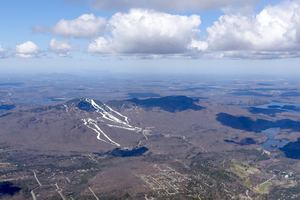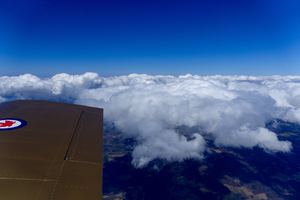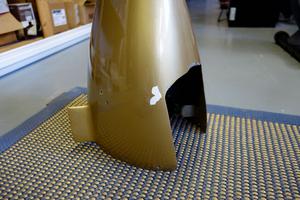Sherbrooke Lunch Flight
- Details
- Written by Kevin Horton
- Hits: 3453
Spring has finally arrived, and the weather today was gorgeous. Terry and I took advantage with our first lunch flight of the year, to Sherbrooke, QC. The last time we were at Sherbrooke was our second last flight together last year, during the peak of the fall leaves. Sherbrooke has a very nice airport restaurant, and friendly and helpful line staff. It is always a pleasure to stop there.
We hope to start doing longer trips with the aircraft in a few weeks, so this was a good chance for Terry to get reacclimatized to travelling by RV–8.
 We were quite shocked to see several ski hills with all the ski runs still covered by snow. They must have made snow until very late in the season. Here is Mount Orford, near Magog, QC. It was open until 07 April 2015, which was the earliest it had closed in the several seasons. In 2014, it was open until 18 April.
We were quite shocked to see several ski hills with all the ski runs still covered by snow. They must have made snow until very late in the season. Here is Mount Orford, near Magog, QC. It was open until 07 April 2015, which was the earliest it had closed in the several seasons. In 2014, it was open until 18 April.
 On the way home, clouds had moved in near Sherbrooke - we climbed up to 10,000 ft to get on top to find smooth air.
On the way home, clouds had moved in near Sherbrooke - we climbed up to 10,000 ft to get on top to find smooth air.
Crosswind Practice
- Details
- Written by Kevin Horton
- Hits: 3453
I took a day off yesterday to take advantage of the wind, which were blowing 15 kts or so, 60° off the runway heading. This was pretty much perfect for some crosswind landing practice - enough wind so I could work on keeping the fuselage aligned with the runway, touch down with the into wind wheel first, and try to keep it all perfectly on centreline. But not so much wind that I needed to bring along a spare set of underwear. It was a good flight.
Sun 'n Fun Dreams Dashed
- Details
- Written by Kevin Horton
- Hits: 3720
At one point I was hoping to depart for Sun ’n Fun (SNF) in Lakeland, FL (KLAL) yesterday. Sun 'n Fun is a fly-in somewhat similiar to the big EAA fly-in at Oshkosh in July, but quite a bit smaller. I was supposed to be on the road this week, but that trip eventually got delayed, so I tentatively booked a week of vacation, and did the preliminary planning. I had flown the RV-8 to SNF once before, in 2012.
The nominal plan was to fly to Brunswick, GA (KBQK) on Monday and overnight there. I would have flown the last leg into SNF on Tuesday AM, and flown all the way home on Friday. I could make it all the way to SNF in one day, but that would have me setting up camp in the hot humid weather late in day, and then rushing onto the main site to find food before they stopped serving. That didn’t sound like fun at all, which is why I intended to stop overnight in southern GA.
The big SNF plan came off the rails when I got sick last week. I recovered over the weekend, but I am now way behind schedule at work, and can’t really afford to take this week off. The weather for the week at SNF isn’t looking terribly enticing either, with a front hanging around and frequent showers.
 The weather yesterday wouldn’t have made for an enjoyable travel day. It was cool here, with rain all day. It wouldn’t have been possible to go IFR out of here, as I would have been flying in cloud, with the temperature below freezing, and likely picking up ice. The ceiling and visibility were high enough to go VFR underneath the cloud, but that wouldn’t have been enjoyable at all.
The weather yesterday wouldn’t have made for an enjoyable travel day. It was cool here, with rain all day. It wouldn’t have been possible to go IFR out of here, as I would have been flying in cloud, with the temperature below freezing, and likely picking up ice. The ceiling and visibility were high enough to go VFR underneath the cloud, but that wouldn’t have been enjoyable at all.
The winds at my original planned IFR cruise altitude were very strong from the south - I would have had about a 65 kt headwind at the start, decreasing as I clawed my way south. There were also signficant thunderstorns in a system going by Brunswick, GA, so I would have had to stop somewhere further north. I’m glad I wasn’t dealing with all that yesterday.
Trashed ASI :(
- Details
- Written by Kevin Horton
- Hits: 3725
This has been a pretty rough week, as I came down with a very nasty cold Monday night. I’m still not quite recovered, but I am feeling a lot better than I did a couple of days ago.
Saturday a week ago I had my biannual check down on the transponder and altitude encoder. Dan from Canadian Airmotive Avionics came by the hangar after lunch to do his magic. The altitude encoder and transponder passed, with one small adjustment on the encoder to put it bang in the middle of the tolerance - it would have passed without the tweak, but it was reading about 75 ft out.
The quick disconnect fittings in the pitot and static system caused hell though. I had done leak checks on both systems the weekend before, found small leaks, and fiddled with the fittings until both were leak free. But on Saturday, a week later, both systems had small leaks again, but within tolerance. Then as he was applying vacuum to bring the altitude up to 14,800 ft for the last check, one of the fittings in the static system developed a huge leak. He slowly released the vacuum, to stop the test. We broke into the system to isolate the altimeter and altitude encoder from the rest of the plumbing, and finished the test with only that portion of the system under vacuum.
After the test, I reconnected everything and did pitot and static leak checks again - both systems had very small leaks, well within tolerance. I suspect that those quick disconnect fittings are perhaps not rated to take the over 6 psi of vacuum that is present during the transponder checks.
On Sunday I went for a flight, and was dismayed to see that the analog airspeed indicator was reading about 30 kt high. I discussed this with Dan on Tuesday, and he pointed out that the ASI would have been subjected to excessive pressure differential between the pitot and static sides when that fitting developed a massive leak. Vacuum is applied to both the pitot and static systems during that test, otherwise the large pressure differential would damage it (14,800 ft on the static system with no vacuum on the pitot system would be equivalent to 485 kt - my ASI is only good to 250 kt). Worse, the pressure differential during that leak would be like a negative airspeed, as that static input to the ASI would see a higher pressure than the pitot side.
I’ve ordered a new ASI. I’ll also remove the quick disconnect fittings and return to the tried and true Nylo-Seal fittings.
Wheel Pant Touchup
- Details
- Written by Kevin Horton
- Hits: 3729
 I noted a couple of weeks ago that the right wheel pant had some paint missing - it wasn't that visible, as it was on the left side of the pant, quite low down. Looking more closely, the pant had obviously flexed quite a bit for some reason, as there were quite a few cracks in the paint.
I noted a couple of weeks ago that the right wheel pant had some paint missing - it wasn't that visible, as it was on the left side of the pant, quite low down. Looking more closely, the pant had obviously flexed quite a bit for some reason, as there were quite a few cracks in the paint.
 I removed the pant to bring it home to inspect it and touch up the paint. It was clear that the tire had hit the aft edge of the cutout in the pant, and that caused the fiberglass to flex. I had originally fitted the pants and trimmed the cutout at the bottom using the cheap tires delivered as part of the Finishing Kit. Those tires eventually wore out, and were replaced with a pair of Condor tires. The Condor tires had much more rubber on the them, and were slightly larger than the original tires. I checked the clearances to the cutout in the wheel pants, and concluded that while the clearance was adequate, even if slightly less than with the original tires. It seems I was wrong.
I removed the pant to bring it home to inspect it and touch up the paint. It was clear that the tire had hit the aft edge of the cutout in the pant, and that caused the fiberglass to flex. I had originally fitted the pants and trimmed the cutout at the bottom using the cheap tires delivered as part of the Finishing Kit. Those tires eventually wore out, and were replaced with a pair of Condor tires. The Condor tires had much more rubber on the them, and were slightly larger than the original tires. I checked the clearances to the cutout in the wheel pants, and concluded that while the clearance was adequate, even if slightly less than with the original tires. It seems I was wrong.
 This weekend I touched up the white patch with some model aircraft paint, and enlarged the cutout slightly. The paint is not exactly the same shade gold, but it isn't too far off, and doesn't jump out at you.
This weekend I touched up the white patch with some model aircraft paint, and enlarged the cutout slightly. The paint is not exactly the same shade gold, but it isn't too far off, and doesn't jump out at you.
Today I put the wheel pant back on, and checked the clearances on the other wheel pant - they seem OK. I had hoped to do some aerobatics today, but there was a quasi-stationary front a bit south of us, and the ceiling was only about 2500 ft. I did get a short flight off. I had hoped for a longer flight, but the ceilings were fairly low not too far west of the airport, so I didn't go too far from home.
Found and Fixed a Small Pitot Leak
- Details
- Written by Kevin Horton
- Hits: 3728
I didn’t get flying last weekend, as the altimeter was out getting its required biannual calibration. I got it back during the week, and reinstalled it today. I was very happy to find no leaks in the static system after reinstalling the altimeter, as there are roughly two dozen different connections in the system, so it is a nightmare to track down any leaks. I also did a pitot system leak check while I was at it, and found that there was a small leak. It turned out to be a loose quick disconnect fitting where the pitot line from the “round dial” airspeed indicator connected to the main pitot manifold. The line was perhaps a bit short, so it was pulling on the connector. I couldn’t get it to snap into place in the fitting, so I replaced it with a longer new piece of pitot line, and the next leak check was perfect.
I’m using quick-disconnect fittings sold by SteinAir. There are quick to hookup, but I find them a bit sensitive to too short line. I’ve also found that if you disconnect and reconnect a line end too many times it stops making a good seal so you need to replace that section of line.
An ideal pitot system has no leaks, and there is air flowing in the system only when the airspeed changes. When the airspeed increases, the pressure at the entrance to the pitot tube increases, which compresses the air in the pitot system. Air flows in from the pitot tube until the whole system is at the same pressure, then the air flow stops. When the airspeed decreases, the pressure at the entrance to the pitot tube decreases, and the higher pressure air inside the pitot system expands and flows out the pitot tube until the whole system is at the same pressure once again.
Air flowing in a system requires a pressure difference to drive the flow - it flows from high pressure to low pressure. The amount of pressure difference required depends on the speed of the flow, the diameter and length of the piping (plus many other factors). The effect of a pitot leak depends on how large the leak is, and where it is in the system. Small leaks close to the pitot tube have negligible effect, as the length of the piping between the pitot tube and the leak is small. In fact, most pitot tubes have a small leak built in, as they have a water drain near the entrance to the pitot tube. There is only a short distance between the entrance to the pitot tube and the water drain, and the cross section is large, so only a very tiny pressure drop is created by the flow to replace the air lost through the water drain. Leaks near the instrument panel have a larger effect, as the air must flow through many feet of piping, which requires a larger pressure difference between the pitot tube and the leak to drive the flow.
I don’t have an easy way to calculate the effect on the airspeed accuracy of the leak I found. The indicated airspeed for a given power setting doesn’t seem to changed much since the last time I did a pitot system leak check, so I suspect the effect of the leak was minimal.
I did get flying today, which was much appreciated. I checked out all the major systems and avionics, to be sure the aircraft is ready for the cross country flying season.

